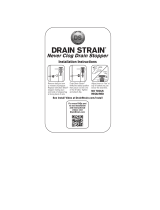
1918
Conexiones Eléctricas
Cableando el Triturador Directamente
a la Corriente de la Casa
Este artefacto debe ser conectado a
un sistema de cableado puesta a tierra
permanente de metal o un equipo conductor
de puesta a tierra, debe ser puesto en
funcionamiento con los conductores del circuito
y conectado al terminador o cable del equipo
de puesta a tierra en el artefacto.
A. Si usted usa un cable BX:
1. Instale el cable conector en el hoyo.
2. Conecte el alambre blanco al cable
blanco del triturador.
3. Conecte el negro.
4. Conecte el puesta a tierra desnudo.
Si el cable BX no es usado, provéase de un
cable de puesta a tierra separado de la
tubería de metal de agua fría más cercana
y otro puesta a tierra adecuado, usando el
tornillo de la campana nal para el alambre
de puesta a tierra (vea C).
B. Si su suministro de energía no incluye
un alambre de puesta a tierra, debe
proporcionar uno a menos que un cable
metálico sea usado. Adjunte un alambre de
cobre en forma segura al tornillo de puesta
a tierra del triturador y adjunte el otro
extremo del alambre a la tubería metálica
de agua fría. Use solamente una abrazadera
de puesta a tierra aprobada por la UL. Si
se usa una tubería de plástico en su hogar,
un electricista calicado debería instalar un
puesta a tierra en forma apropiada.
TO HOUSE
CURRENT OR
POWER CORD
WIRE NUTS
GROUND SCREW
STRAIN
RELIEF
NUT
A
CB
RED RESET BUTTON
RIBBED SIDE
NOTE: When viewing face of el ectical
plug with grounding pin at top,
the larger left blade is connected to
the identified wire .
Trace lead connected to this blad e
and attach that lead to white wire
on disposer .
REMOVE COVER
PLATE
Instrucciones de Puesta a Tierra
Para Trituradores equipados con un
cable de energía con puesta a tierra
Conectando el Triturador a un Cable de
Enchufe
Este artefacto debe estar puesto a
tierra. En el escenario de una falla o
avería, la puesta a tierra proporciona
un pase de menos resistencia para la
corriente eléctrica y así reducir el riesgo
de descarga eléctrica. Este artefacto
está equipado con un cable que tiene un
equipo conductor de puesta a tierra y
un enchufe de puesta a tierra. El enchufe
debe ser conectado en un tomacorriente
apropiado que esté instalado
apropiadamente y puesto a tierra en
concordancia con todos los códigos y
ordenanzas locales.
Para Trituradores no equipados con un
cable de energía con puesta a tierra
Este artefacto debe estar puesto a tierra.
En el escenario de una falla o avería, la
puesta a tierra proporciona un pase de
menos resistencia para la corriente
eléctrica y así reducir el riesgo de
descarga eléctrica. El cable de energía
(a ser instalado) debe tener un equipo
conductor de puesta a tierra y un
enchufe de puesta a tierra. El enchufe
debe ser conectado en un tomacorriente
apropiado que esté instalado
apropiadamente y puesto a tierra en
concordancia con todos los códigos y
ordenanzas locales.
Desconecte la energía eléctrica al
circuito del triturador antes de la
instalación. Ponga el interruptor
protector en la Conexiones Eléctricas
posición de OFF o quite el fusible.
1. Conecte el triturador solamente a una
corriente de 110-120 Volt, 60Hz.
2. Si se usa un cable de enchufe, use un
enchufe de tres picos (vea A). El cable
de puesta a tierra deberá ser adjuntado
al tornillo de puesta a tierra en la parte
inferior de la campana nal (vea B).
3. Use un conector de alivio de tensión
donde el cable de corriente se introduce
al triturador (vea C).
Rastree el cable conectado a esta hoja
y adjunte ese cable al cable blanco en
el triturador.
LADO REFORZADO
ALIVIO DE
TENSIÓN
TUERCA
BOTÓN ROJO
DE REINICIO
TORNILLO A
TIERRA
TUERCAS DE
CABLE
PLACA CUBIERTA
DE REMOCIÓN
A CORRIENTE
CASERA O
CABLE
DE ENERGÍA
NOTA: Cuando vea la cara del enchufe
eléctrico con el pin de tierra en la
cima, la hoja izquierda más grande
está conectada al cable identificado.






















